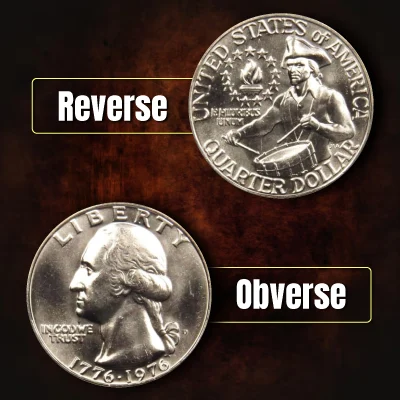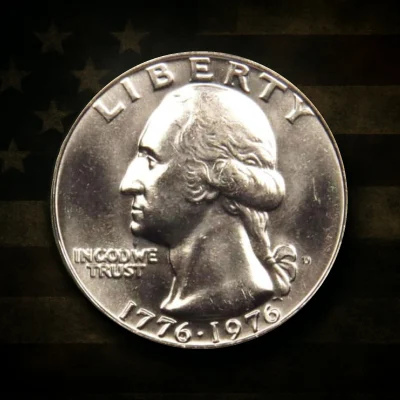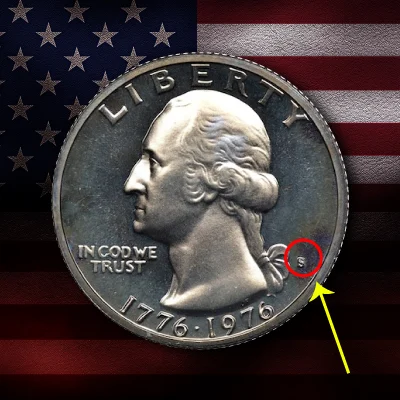
Quarters are often regarded as mere pocket change, but some quarters that your grandpa probably hid in his suitcase could not be just regular silver coins, but your ticket to generational wealth. The commemorative coin known as the 1976 Bicentennial Quarter was created to mark the 200th anniversary of the United States.
Along with the quarter, half dollar, and dollar, these quarters are part of a unique Bicentennial coinage campaign. This campaign became one of the most successful in American history, sharing the stage with names like Wheat penny and Lincoln Cent.
These quarters are rather common among collectors, with almost 1.6 billion made. However, because of their scarcity, some mistake coins—like those with a rich cameo finish or a double die obverse—can be quite valuable. Bicentennial quarters, especially those with uncommon mint marks, are highly sought for by coin collectors. These coins can command high market prices, particularly when they are in perfect condition.
Bicentennial Quarters mark the 200th anniversary of the Declaration of Independence, a critical moment in U.S. history. Produced as part of a broader initiative, these coins celebrate this landmark event, making them significantly more valuable to collectors. Mary Brooks, the Mint Director at the time, oversaw the design competition for these quarters.
The first Washington Bicentennial quarter was struck in 1932, way before the commemorative Kennedy half dollar in 1964.
The original quarters featuring the Washington effigy minted in 1932 composed of 90% silver and 10% copper. But the 1976 quarters also feature the same composition. The obverse was designed by Laura Gardin Fraser and the reverse designer was John Flanagan until 1998 before being replaced by Benjamin Sowards, sculpted by Michael Gaudioso, which featured the President crossing the Delaware river in 1776. The 1975-76 and 1998-2021 issues of the quarter featured various designs due to its commemorative nature.
Bicentennial Quarters symbolize America’s rich history that creates a sense of patriotism which is sustainable for ages. These bicentennial coins, commemorating the 200th anniversary of American independence, have been around for over 45 years. Unlike other quarters, they feature the dates 1776 and 1976, regardless of when they are struck, creating a unique foothold in the American coinage history.

The reverse side features a colonial drummer boy quarter, symbolizing the fight for freedom during the American Revolution, surrounded by thirteen stars representing the original thirteen colonies, along with the designer’s initials at the bottom.
The obverse shows a profile portrait of George Washington with the motto ‘E PLURIBUS UNUM,’ meaning “Out of many, One”. Philadelphia-minted quarters lack a mint mark, distinguishing them from Denver-minted coins.
It initially contained 6.25 grams of 90% silver until 1964 when it switched to a base-metal composition of cupronickel (75% copper, 25% nickel) clad to a pure copper core. Non-circulating versions of the quarter containing silver have also been produced for collectors since 1976.TheWashington quarters were struck at three facilities of the US mint that are Philadelphia, Denver, and San Francisco. These mints were the primarily preferred mints with Philadelphia as the one assigned for mass production of American Coinage. These mint had a dedicated mintmark for themselves giving the quarters a unique identity and valuation criteria.
Here's a detailed description of the mintage and value of the quarter at each mint:

Around 810 million Bicentennial Quarters were minted in Philadelphia in 1976. These quarters, made of cupronickel-clad material, lack a mint mark. 809,784,016 quarters were struck at this mint, signifying its ability of bulk production.
The Philadelphia-minted quarters are clad coins, composed of layers of copper and nickel, which is typical for most Bicentennial Quarters.
A common trait for Philadelphia-minted quarters is that they were struck in tremendous numbers, emphasising quantity over quality, especially when produced in limited quantities and large quantities.

A small mint mark ‘D’ on the obverse side identifies Denver quarters minted Bicentennial Quarters. A total number of 860,118,839 quarters were struck at the Denver Mint, which is relatively low, and thus fetch higher values.
The Denver Mint played a key role in producing these commemorative coins at the U.S. Mint.

The San Francisco Mint produced both proof and business strike quarters. Proof Bicentennial Quarters from San Francisco bear the ‘S’ mint mark and feature a shiny, mirror-like finish.
These quarters are composed of multiple metals, including 60% copper and 40% silver content, this iconic composition has been a collector favorite for years.
Containing 40% silver and 60% copper, the proof Bicentennial quarters are more valuable.
Errors are manufacturing defects incurred on the coins during the minting process. These errors, ironically, don’t reduce the value, but rather increase it drastically since errors are significantly rare.
Certain errors, like double die errors, significantly increase market value as a minting error rather than a humanly-created one. The doubling effect, resulting from the design being stamped twice, is a notable error that can significantly increase the value of a Bicentennial Quarter. Some error coins can be valued up to $10,000, proving their demand among discerning coin collectors.
Below are some of the rarest bicentennial quarter errors along with notable ones:
The Double die error is a rare bicentennial quarter which displays a same coin planchet struck twice (generally), resulting in a doubled strike often visible on the letters and edges. This error can be observed on the obverse as Double Die Obverse (DDO) or the reverse design as DDR, and even on both.
In Bicentennial Quarters, inscriptions on both sides may appear doubled due to a poorly made double die obverse.
The coded designation for the double die error on Denver Bicentennial Quarters is FS-101.
A clipped planchet error occurs when a quarter is minted with a piece missing, making it rare. A 1976 quarter with a double clip sold for $89 at auction, indicating the value such errors can carry.
A strike-through error is an error where a foreign object or organism makes a lifelong appearance in the process and gets imprinted on the coin. This can significantly increase the coin’s value. An overstruck Bicentennial Quarter, like one struck on a 10C dime, can be very valuable.
Some Bicentennial Quarters were overstruck on other coins, such as dimes, creating unique and highly valuable error coins. An off-center 1976 Bicentennial Quarter sold for $575 at auction.
Other notable errors include doubled die, overstruck, and struck-through errors.
Certain 1976 Bicentennial Quarters, especially those with significant errors, can be valued up to $10,000.
Some of the rarest varieties, such as the 1976 MS67+, 1976-D MS68, and 1976-S MS69 Silver quarters, fetching prices as high as $45,000.
An auction record depicts a 1976 S uncirculated quarter in MS69 condition that was sold at $19,200, showcasing strong demand for high-quality examples.
Furthermore, the proof 1976 bicentennial quarters worth was already high with the cameo designs. The deep cameo bicentennial quarters are finely struck quarters that are sharper than most proof bicentennial quarters.
The coin's condition and its corresponding grade impact the value of Bicentennial Quarters, with high-grade examples commanding much higher prices. Many coins are in excellent condition, making high-grade examples relatively common. The condition and grading scale go hand-in-hand ranging from 1 to 70, where 1 being the lowest and 70 being the most pristine condition.
Coins graded MS70 or regarded as uncirculated coins represent the highest quality and command significantly higher prices. When grading the proof bicentennial quarters, the grades are abbreviated as "PR."
Certain 1976 Bicentennial Quarters may significantly increase in value if they are scarce and in high demand. Errors like a clipped planchet and double die are rare. Thus, their demand is high, leading them to have a much higher value.
Regardless of the coin being a quarter or a half-dollar, or even a dollar, having an error on the coin drastically increases its value. Furthermore, if the error is rare, then you can be set up for generational wealth.
Even if you don’t have a bicentennial quarter today! Don’t worry! The future of 1976 Bicentennial Quarters looks promising among coin enthusiasts. As the collector community grows and time flows, rare error and pristine condition Bicentennial Quarters worth will potentially soar, generating wealth for your future generations.
It's essential that you get your quarters assessed by Numismatic Guaranty Company (NGC) or Professional Coin Grading Service (PCGS), which are globally approved and accepted coin graders, to get the most optimal appraisal for the coins.
Bicentennial Quarters are, of course, worth more than 25 cents, their face value. As mentioned, the condition or grade, mint mark, and errors significantly impact the value of these quarters. Being struck at three different mints of Philadelphia, Denver, and San Francisco, these Quarters were highly demanded for their difference in mintage.
Regardless of the value, these quarters are a sign of America’s pride and greatness that has been consistent in every heart throughout generations. As a member of the coin collecting community, you should definitely find a 1976 Bicentennial quarter and expand your collection.
Happy collecting!